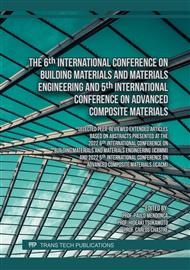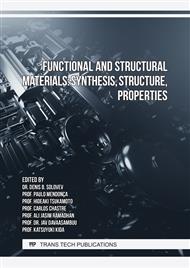[1]
Nassar, M.M.A., et al., New Synthesis Routes toward Improvement of Natural Filler/Synthetic Polymer Interfacial Crosslinking. Polymers, 2022. 14(3): p.629.
DOI: 10.3390/polym14030629
Google Scholar
[2]
Rabbani, F.A., et al., Experimental Study of Mechanical Properties of Polypropylene Random Copolymer and Rice-Husk-Based Biocomposite by Using Nanoindentation. Materials, 2022. 15(5): p.1956.
DOI: 10.3390/ma15051956
Google Scholar
[3]
Babacar Niang, A.K.F., Abdoul Karim Mbodji, Nicola Schiavone, Haroutioun Askanian, Vincent Verney, Diène Ndiaye, Abdoulaye Bouya Diop, Bouya Diop, Contribution to the Study of the Thermal, Rheological and Morphological Properties of Biocomposites Based on Typha/PP. nternational Journal of Materials Science and Applications, 2022. 11(1): p.8.
DOI: 10.11648/j.ijmsa.20221101.15
Google Scholar
[4]
Khieng, T.K., et al., A Review on Mechanical Properties of Natural Fibre Reinforced Polymer Composites under Various Strain Rates. Journal of Composites Science, 2021. 5(5): p.130.
DOI: 10.3390/jcs5050130
Google Scholar
[5]
Monteiro, S.N., et al., Thermogravimetric Stability of Polymer Composites Reinforced with Less Common Lignocellulosic Fibers – an Overview. Journal of Materials Research and Technology, 2012. 1(2): pp.117-126.
DOI: 10.1016/s2238-7854(12)70021-2
Google Scholar
[6]
Saravanakumaar, A., A. Senthilkumar, and B. Muthu Chozha Rajan, Effect of Fillers on Natural Fiber–Polymer Composite: An Overview of Physical and Mechanical Properties, in Mechanical and Dynamic Properties of Biocomposites. 2021. pp.207-233.
DOI: 10.1002/9783527822331.ch11
Google Scholar
[7]
Jagadeesh, P., et al., Effect of natural filler materials on fiber reinforced hybrid polymer composites: An Overview. Journal of Natural Fibers, 2020: pp.1-16.
DOI: 10.1080/15440478.2020.1854145
Google Scholar
[8]
Lu, N., S. Oza, and M. Tajabadi, Surface Modification of Natural Fibers for Reinforcement in Polymeric Composites. 2015. pp.224-237.
DOI: 10.1002/9781119044901.ch9
Google Scholar
[9]
Faiad, A., et al., Date Palm Tree Waste Recycling: Treatment and Processing for Potential Engineering Applications. Sustainability, 2022. 14(3): p.1134.
DOI: 10.3390/su14031134
Google Scholar
[10]
Shaikh, H.M., et al., Isolation and Characterization of Alpha and Nanocrystalline Cellulose from Date Palm (Phoenix dactylifera L.) Trunk Mesh. Polymers, 2021. 13(11): p.1893.
DOI: 10.3390/polym13111893
Google Scholar
[11]
Shaikh, H.M., Thermal, rheological, and mechanical properties of polypropylene/phosphate ore composites. Construction and Building Materials, 2020. 263: p.120151.
DOI: 10.1016/j.conbuildmat.2020.120151
Google Scholar
[12]
Mazzanti, V. and F. Mollica, A Review of Wood Polymer Composites Rheology and Its Implications for Processing. Polymers, 2020. 12(10): p.2304.13.
DOI: 10.3390/polym12102304
Google Scholar
[13]
Nassar, M.et al., New Synthesis Routes toward Improvement of Natural Filler/Synthetic Polymer Interfacial Crosslinking. Polymers, 2022. 14(4): p.629.
DOI: 10.3390/polym14030629
Google Scholar
[14]
Soury, E., et al., Rheological Investigation of Wood-Polypropylene Composites in Rotational Plate Rheometer. Journal of Polymers and the Environment, 2012. 20(4): pp.998-1006.
DOI: 10.1007/s10924-012-0502-x
Google Scholar
[15]
Durmus, A., M. Ozcan, and I. Aydin, Quantifying effects of compositional variations on microstructural properties of polypropylene-wood fiber composites by melt rheology and tensile test data. Journal of Composite Materials, 2019. 53(4): pp.503-514.
DOI: 10.1177/0021998318786792
Google Scholar



